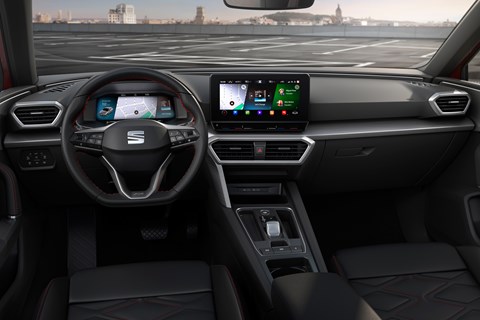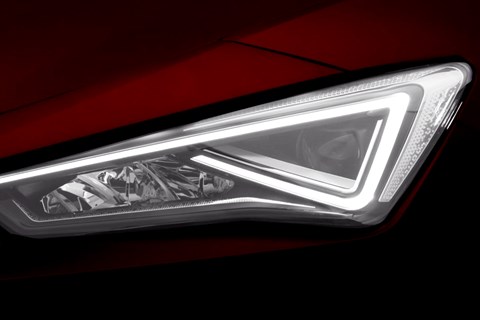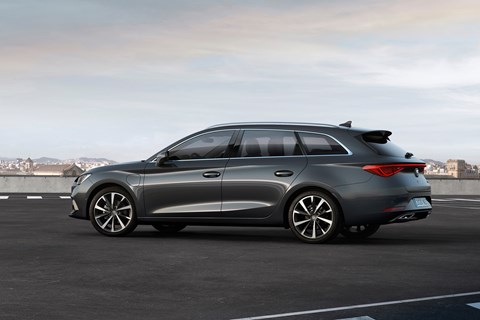► 2020’s Seat Leon prices, specs, details
► New family hatch ups the tech
► Shares a lot with Golf 8, naturally
Prices for the new Seat Leon have been announced, and the popular mid-sized hatchback will cost from £19,855 in the UK. For those preferring monthly payments – as most Brits do – PCP finance payments start at just £195 a month.
The cheapest Leon at the foot of the range is the 1.0-litre TSI 110ps SE six-speed manual. Prices for the Leon estate kick off at £22,455 for the larger-engined 1.5 130ps SE.
New 2020 Seat Leon: the back story
Evolution not revolution is the story of the 2020 Seat Leon, which was due to debut at the cancelled 2020 Geneva motor show. It enters its fourth generation on the back of 2.2 million sales since 1999, and as the company’s biggest-selling model (for now), one senses that the Spanish brand has no intention of taking any risks here. But although there’s a sense of déjà vu, that takes nothing away from what is a good-looking new car.
So, although they’ve played it safe and modelled it on the previous 2014 version, it’s still a sharp-looking car – as you’d expect from a car with such pleasing proportions. It’s honed for aero with a drag coefficient that’s 8% better than before, it’s bedecked with the latest LEDs front and rear, and it’s fronted by the new family grille lifted straight from the recently-launched Tarraco SUV.

Just to make sure new buyers feel they’ve bought something completely new, it also gets a full-width LED rear lightbar and new ‘Leon’ scripting on the tailgate. Seat’s design director Alejandro Mesonero-Romanos sums it up in designerspeak: ‘it still presents itself as a bolder vehicle than the previous generation, and keeps hold of the brand’s DNA and the representative attributes of a Leon. The exterior mixes the car’s key characteristics of confidence, elegance and sportiness.’ Quite.
The looks might be predictable, but the tech under the skin has been updated in-line with the its Volkswagen Group siblings, the Volkswagen Golf and Skoda Octavia. As well as these two, the Leon is likely to end up on the same shopping lists as the Ford Focus, Mazda 3, Toyota Corolla, Peugeot 308 and Renault Megane, as well as the countless small SUVs that buyers are increasingly turning to.
Engine options: petrol, diesel, hybrid and plug-in hybrid
The powertrain mix is predictable, too, although no less excellent for it. There are now essentially four options: petrol (TSI), diesel (TDI), mild hybrid (eTSI), and plug-in hybrid (eHybrid) versions, and manual and DSG versions are available pretty much across the board. Petrols start at the excellent 109bhp 1.0-litre triple, via the 1.5-litre TSI Evo up to the 187bhp 2.0-litre. Diesels come in 128 and 148bhp flavours and will be very familiar to anyone familiar with the wider Volkswagen Group range.

Of more interest is the eTSI mild hybrid system, which is available with either the 1.0- or 1.5-litre petrol engines. There’s a 48 Volt Integrated Starter Generator, which allows the car to coast at certain speeds, shutting off the petrol engine completely. As well as that, there’s cylinder cut-off technology, too, which results in is better fuel economy and lower emissions than the non-hybrid – although full figures are yet to be revealed. There’s also a modest electrical boost from the hybrid system under acceleration, too.
The eHybrid plug-in hybrid version shares its drivetrain with the Volkswagen Passat GTE, and is now well established. It combines a 13kWh battery pack and electric motor with its 1.4-litre petrol engine – and comes with all those juicy PHEV side-benefits, not least its low tax. Maximum power is 200bhp, and its electric-only range is a not-unimpressive 38 miles. You can plug it in to a standard electric car charge point, and Seat says it wlll fully charge from empty in around 3.5 hours on a typical domestic charger.
Uprated tech brings it up to date
The biggest change is to the dashboard, which gets a much sleeker look, fewer individual buttons and more controls via the on-trend prominently-mounted central touchscreen. Central to the Leon’s control set is SEAT’s Digital Cockpit, which combines a 10.25-inch instrument cluster with the aforementioned 8.25 or 10.0-inch central touchscreen. As you’d expect, it’s a fully-equipped infotainment system, with connected sat-nav, wireless charging, voice control and gesture recognition.

Seat says that its updated voice recognition responds naturally and means you can converse with it in a more ‘human’ way. Tell the Leon that you’re cold, and it will raise the temperature.
Seat’s connected services play a central role here, too, but for those who’d rather chew through their own data, full wired and wireless Apple CarPlay is available as is Android Auto.
The embedded SIM keeps the car online whether it’s connected to your phone or not and as well as keeping the inbuilt sat-nav maps up-to date with traffic information, but the car’s inbuilt eCall service will contact the emergency services for you in the event of an incident.
Heading to the top of the class?
It’s packed with standard and optional safety systems. There’s a predictive adaptive cruise control system, which uses mobile and satellite traffic data along with traffic-sign recognition to automatically set the car’s speed depending on the conditions ahead. It will also assist the steering and will potentially anticipate dangerous situations up ahead. It’s not a ‘hands-free’ system, though, and list all of these systems, there will be warnings from the car if the driver takes their hands off the steering wheel for more than 15 seconds.

The Leon also now comes with full LED headlights, which are brighter and work better on dipped and main beam. Top models come with fully automatic and adaptive lighting. This is in addition to the usual suite of systems that includes Autonomous Emergency Braking (AEB) as part of SEAT’s advanced driver assistance system (ADAS).
More practicality, more space
Both the new Leon hatch and estate have a longer wheelbase than before, which SEAT says gives the rear-seat passengers 5cm more kneeroom. Headroom is up in the front (by 3mm) and down in the rear (by 1mm) for the hatchback; and it’s up in the front (by 1mm) and rear (by 5mm) in the estate version. Boot space remains unchanged in the hatchback (at 380 litres) and is up from 587 to 617 litres in the estate.
The model line-up again has a familiar feel. You get SE, SE Dynamic, FR, FR Sport, Xcellence and Xcellence Lux. They’re well-equipped with the even the entry-level SE throwing in keyless starting, electronic parking brake, full infotainment set-up, leather steering wheel and SEAT’s connected features.

When can you buy one?
You can pre-order a Leon now, although prices haven’t been confirmed. Delivery times for the UK are to be confirmed, too, but expect them to start arriving the summer. Expect prices to take a bit of a hike in line with all that new equipment, but it’ll still be cheaper than the Volkswagen Golf.
It might spark the debate as to what all-new means. SEAT says that Leon v4 is just that, but it’s hard to see this as anything other than a comprehensive makeover of the old one – as excellent as it is. The good news is that SEAT’s core model now gets all the technology already being churned out of Wolfsburg, and that’s a very good thing.
This one is a step-change, and the new hybrid and plug-in models undoubtedly add massive buyer appeal for all those wanting to make a break with diesel – and if the popularity of the old Golf GTE is anything to go by, there may well end up being a long queue. For those looking for a family car bristling with the latest tech, and with great looks to match, the SEAT Leon is certainly a player.
Check out our Seat reviews